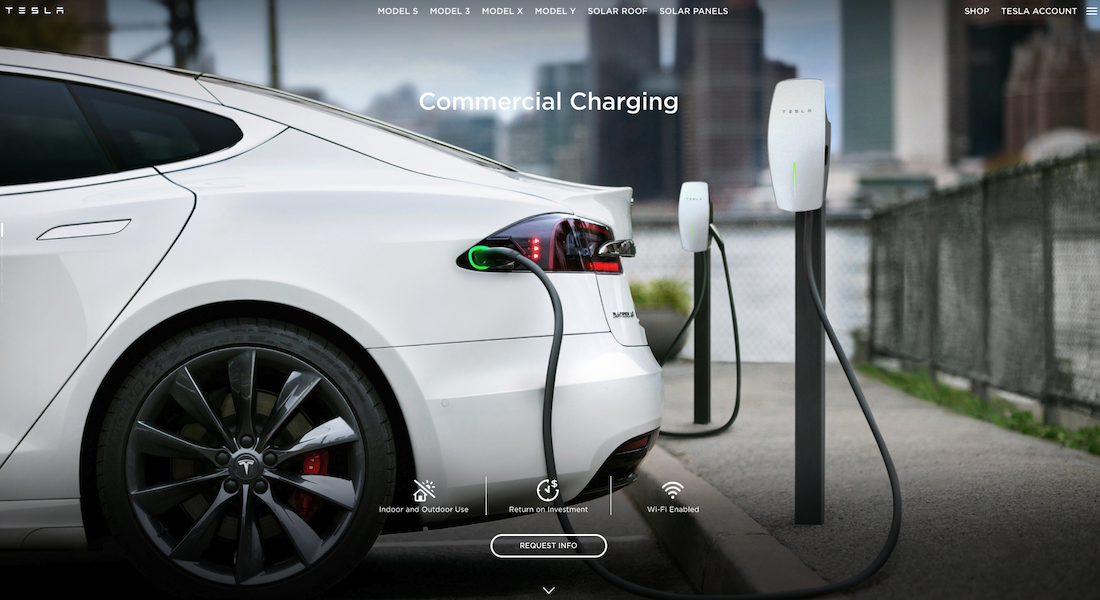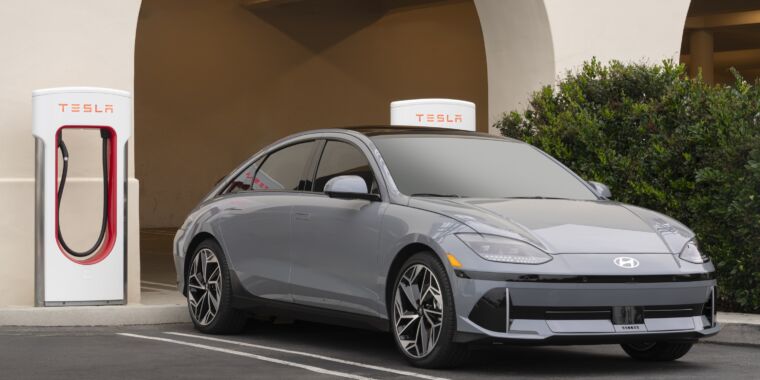Welcome to Tesla Motors Club
Discuss Tesla's Model S, Model 3, Model X, Model Y, Cybertruck, Roadster and More.
Register
Install the app
How to install the app on iOS
You can install our site as a web app on your iOS device by utilizing the Add to Home Screen feature in Safari. Please see this thread for more details on this.
Note: This feature may not be available in some browsers.
-
Want to remove ads? Register an account and login to see fewer ads, and become a Supporting Member to remove almost all ads.
You are using an out of date browser. It may not display this or other websites correctly.
You should upgrade or use an alternative browser.
You should upgrade or use an alternative browser.
Supercharger Revenue
- Thread starter Buckminster
- Start date
-
- Tags
- supercharger v3
10 average per hotel. Not sure where this data came from.
It seems that is a little misleading, as it sounds to me like Hilton is installing them, not Tesla.10 average per hotel. Not sure where this data came from.

Tesla to Supply Hilton Hotels With 20,000 EV Chargers by 2025
Hilton Worldwide Holdings Inc. is partnering with Tesla Inc. to install 20,000 universal electrical vehicle chargers at 2,000 of its hotels in the US, Canada and Mexico.
The McLean, Virginia-based company said it plans to have at least six wall-mounted chargers at selected hotels that will work with any electric vehicle model, beginning in 2024. The move would make Hilton’s EV charging network the largest of any hospitality company, the hotel group said. It would also expand Tesla’s dominance in EV charging.
So, it sounds like 6 Wall Connectors by default, with some locations having more.
They mention installing a minimum of 6 per site, which is how many Tesla requires to be installed in order to add them to their commercial charging plan. At which point the host can set the price per kWh, which Tesla will bill and pass on to the host. (And then charge a one cent per kWh fee, billed once per year.)
Tesla vehicles are authorized just like Superchargers, just plug in and charge. Non-Tesla vehicles have to start charging via the app.
Artful Dodger
"Neko no me"
This 3rd-party billing feature was made available by Tesla over 2.75 years ago, it's just that Hilton is the 1st large organization to take advantage of the program:
Tesla adds option for 3rd party billing at Destination Chargers in Software Update | driveteslacanada.ca (2020-12-01)

 driveteslacanada.ca
driveteslacanada.ca
Miniumun 6 destintation chargers per site to qualify. This is precisely what Hilton announced.
Tesla adds option for 3rd party billing at Destination Chargers in Software Update | driveteslacanada.ca (2020-12-01)

Tesla adds option for 3rd party billing at Destination Chargers in latest software update
If you’re a business or property owner with a Tesla Destination Charger on your property, you will soon be able to bill Tesla owners.
 driveteslacanada.ca
driveteslacanada.ca
Miniumun 6 destintation chargers per site to qualify. This is precisely what Hilton announced.
This suggests they will in some cases rip out V2? Superchargers and replace with V3/V4. Sounds like a mistake to me. We are not short of parking spaces or locations without any chargers.Tesla wins a large part of the EU subsidies for fast chargers:
134 million euro (of a total of 352) for “The project aims at deploying 6,458 recharging points (250 kW) for LDV in 613 locations in 16 countries (AT, BE, BG, DE, ES, FI, FR, IE, IT, LV, LT, LU, NL, RO, SK, SE) along the Core and Comprehensive Network. The project foresees both the deployment of new recharging stations and the replacement of existing outdated recharging points not satisfying the requirement of the ca in terms of recharging capacity and open-accessibility.”
And another similar one of 15 million euro for 6 eastern european countries (740 chargers in 74 locations).
So it looks like Tesla is going to upgrade all old superchargers with EU subsidies.
I do think that Tesla need to highlight V2 chargers differently to V3 etc. I would rather go to V2 than non Tesla but maybe want to see them promoted less on the map.
This suggests they will in some cases rip out V2? Superchargers and replace with V3/V4. Sounds like a mistake to me. We are not short of parking spaces or locations without any chargers.
I do think that Tesla need to highlight V2 chargers differently to V3 etc. I would rather go to V2 than non Tesla but maybe want to see them promoted less on the map.
I think there are some deadlines involved in the EU subsidies. Upgrading older sites has probably a lot less uncertainty than permitting and building new sites. And availability of power is also an issue, e.g. in The Netherlands there are regions where no new high voltage connections can be provided anymore because the grid is at its limits.
For a non-Tesla user it also doesn’t make sense that some sites can be used and others not. So I’m happy that the old ones are upgraded. It’s not that the superchargers are routinely overflowing with non-Teslas.
V2 is also too slow for all Teslas except for old Model S/X’es.
Canadian here. In my Tesla app, under Account/Charging, there’s a item that says Membership for Non-Teslas. Clicking on that gets me to the following page:
View attachment 975670
Another Tesla revenue stream:
It appears the price is set, and assumedly collected by, the property owner, and Tesla handles payment processing for free.Another Tesla revenue stream:
How is this a Tesla revenue stream?
I thought I saw that Tesla would be taking a cut. I would be very surprised if they didn't. There are no monthly fees - ie. there will be fees.It appears the price is set, and assumedly collected by, the property owner, and Tesla handles payment processing for free.
How is this a Tesla revenue stream?
The one thing I saw is that Tesla would charge 1 cent per kWh, on an annual basis. So not much of a cut... (But it wasn't anything official.)I thought I saw that Tesla would be taking a cut. I would be very surprised if they didn't. There are no monthly fees - ie. there will be fees.
Ah, gotcha.I thought I saw that Tesla would be taking a cut. I would be very surprised if they didn't. There are no monthly fees - ie. there will be fees.
The post says "Tesla handles payments with no monthly fees", but I guess that doesn't rule out per-payment fees, as you mention. Good point.
Thanks.
This is US only...And this revenue stream could become quite massive. I've been thinking about this a lot lately. With NACS as the standard, Tesla has a significant brand advantage when it comes to selling its L2 charging network. Tesla's L2 network should quickly dwarf companies like ChargePoint.
Just think of all the apartment complexes that are ready to install chargers. The complex gets paid. Tesla gets paid. Residents save money over buying gasoline. Everybody wins except the oil companies.
Analysts have talked about how putting everyone onto the Supercharger network won't bring in a lot of revenue for Tesla. But Supercharging is not where the money is. The big money for Tesla will be in apartments, condos, and businesses offering L2 charging. This is where millions of EVs will charge every day. And Tesla will get a nice cut.
Let's throw out some napkin math.
From what I gather, about 25% of US drivers don't live in a place where they could install a private charger. So they would rely on an L2 network like Tesla's. Let's say we are at a point where 25% of the US fleet is electrified. The fleet is currently about 290 million cars. So that's about 18 million who need to charge on L2. And let's say it averages about $5 per day of revenue per car and Tesla has a 50% share of the L2 charging market. Tesla's revenue is split 50/50 with the owner of the property. (Note that I'm assuming the $5 is after paying the utility for the electricity)
So we have:
18,000,000 x 50% x $5 = $22.5 million per day split evenly with the property owners.
We are talking about roughly $8 billion in revenue per year going to Tesla. And it's mostly profit.
But they won't appear on the all important Tesla charger map:I'd be very surprised if Tesla gets to double digit % market share for L2 chargers. The L2 charger is basically a commoditised product at this stage because it is trivial for any company that already manufacturers electrical products to move into this adjacent product and they all know how many are needed in the long run. There's also no limit to scaling like we have with batteries in vehicles. Tesla's offering isn't the cheapest. When building management is deciding to purchase hundreds of L2 chargers there are cheaper offerings.
Tesla will improve the map a lot over time. They need to distinguish between paid versus free, available to customers versus customers, available right now versus need to phone ahead, number of chargers plus kW etc.
I still think Tesla can capture 50% of the L2 network market if they want to go after it. Here is why I think Tesla has a huge advantage in L2:
- Tesla can scale production of the chargers to a massive number and achieve a level of cost and quality that nobody else will be able to touch.
- Tesla's NACS connector is becoming the standard. Tesla has been the only ones producing them for years, so others will be far behind in offering and manufacturing NACS plugs.
- During the time of transition to NACS, Tesla has the universal chargers with the J1772 adapter built in. Nobody else has this.
- Tesla will continue to dominate the EV market in North America for several years to come. So customers with Teslas will naturally prefer Tesla's chargers. Building management knows this. They will trust the Tesla brand over others.
- Tesla's L2 network software will be vastly superior to the others in everything from the customers experience in the app to the payment system to software for building management. Tesla just makes great software.
- Tesla's maintenance costs will be less. This is partially because of scale and partially because they manufacture a more durable, high-quality charger.
I believe that hotels will soon let you reserve a charger with your room. There will likely be an extra fee, but this will give the guest some confidence that he can charge up while sleeping. For road trippers it will be great to know that you won't have to visit a Supercharger first thing in the morning.
We knew this was coming, but might be worth a little pre-market bump:

Hyundai is switching to Tesla-style NACS plugs for its EVs in late 2024
Hyundai EVs that still have the CCS1 plug will get access in 2025 with an adapter.arstechnica.com
Similar threads
- Replies
- 26
- Views
- 3K
- Replies
- 1
- Views
- 2K
- Article
- Replies
- 39
- Views
- 3K
- Replies
- 17
- Views
- 3K


